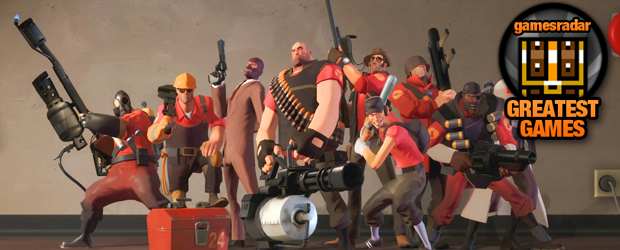Why Team Fortress 2 is one of the greatest games ever made
That answer kind of depends

What year are we talking about? The question needs to be asked because Valve's Team Fortress 2 is like Madonna in this way, where each period of invention and reinvention warrants acclaim in its own right, in many cases warrants inclusion to this list in its own right, but when taken together, culminate to form a true picture of greatness.
Let’s say the year is 2006. Valve’s been toying with the emotions of Half-Life 2 fans for some time, and, perhaps as a makegood, the company signals a return of its cult-favorite Quake mod in Team Fortress 2. Better yet, the game will come as a pack-in to the indomitable Orange Box, which also includes Half-Life 2, its two expansions, and the juggernaut-in-waiting, Portal. (And before we move on, let’s just pause, take a moment and marvel at the absurd, likely never-to-be-topped value of The Orange Box. Breathe that digression in; it’s good for you.)
It quickly became clear that Valve had every intention of doing Team Fortress 2 up right. Beginning with “Meet the Heavy” in May 2007, the studio released slickly produced, and uniformly hilarious, promos for each of the game’s nine classes, a move that provided definition and personality to what otherwise could have been a by-the-numbers class-based shooter. The videos also highlighted the variance in each character, their strengths and weaknesses, which served as an early indication of Team Fortress 2’s overall balance.
See, beyond the pomp and panache of its promotion, Team Fortress 2 is actually a very, very good class-based shooter. Best in class, one might say. The point-to-counterpoint balancing saw scouts running circles around demomen, demomen wrecking engineers, engineers wrecking pyros, pyros roasting scouts, and soldiers braining soldiers. This list could go on.

Matches by design devolve into a free-for-all of controlled chaos, where players run amok or work together through myriad maps, chasing intelligence or pushing payloads or capping points. Maps are intuitive, conflict is where it ought to be, and it takes very little time for new players to learn the layout well enough to be a nuisance.
Valve eventually unbundled Team Fortress 2 from The Orange Box; although, it’s worth noting that even when it cost money, it barely cost any money. There were free weekends and cost holidays so business-mindedly mystifying that one could begrudge Valve’s bean-counters for not properly valuing the product.
It’s 2008 by now, and Valve is churning out class overhauls at a steady clip. Actually, overhaul may skew toward understatement. With these updates, Valve at once completely changed the tenor of Team Fortress 2’s gameplay while then again kept things basically the same. It did so by again adeptly walking the tightrope of give-and-take balancing for each of the dozens of new weapons added (for free, mind you). Plus, each item, be it the demoman’s Eyelander sword or the Heavy’s Sandvich, only heightened the game’s immense personality.
Sign up to the GamesRadar+ Newsletter
Weekly digests, tales from the communities you love, and more



